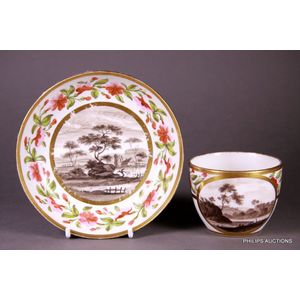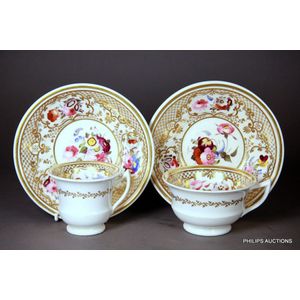Rose Coalport Cups and Saucers, 1812-1815
You must be a subscriber, and be logged in to view price and dealer details.
Subscribe Now to view actual auction price for this item
When you subscribe, you have the option of setting the currency in which to display prices to $Au, $US, $NZ or Stg.
- Diaper Motif - The diaper motif is a repeating geometric pattern in decorative arts that consists of small diamond or lozenge shapes arranged in a grid. The pattern is often used as a background or border on textiles, ceramics, metalwork, and other decorative items. It can be found in a variety of cultures and historical periods, and is often used in formal or ornamental designs. The name "diaper" comes from the pattern's resemblance to the criss-crossed fabric of a baby's diaper.
- Circa - A Latin term meaning 'about', often used in the antique trade to give an approximate date for the piece, usually considered to be five years on either side of the circa year. Thus, circa 1900 means the piece was made about 1900, probably between 1895 and 1905. The expression is sometimes abbreviated to c.1900.
- Gilding - Gilding is a method of ornamentation whereby a thin sheet of gold metal is applied to items made of wood, leather, ceramics, glass and silver for decorative purposes.
For furniture including mirrors, the sheet of gold is usually applied over a coating of gesso. Gesso is a mixture of plaster of Paris and gypsum mixed with water and then applied to the carved wooden frames of mirrors and picture frames as a base for applying the gold leaf. After numerous coats of gesso have been applied, allowed to dry and then sanded a coat of "bole", a usually red coloured mixture of clay and glue is brushed on and allowed to dry, after which the gold leaf is applied. Over time parts of the gilding will rub off so the base colour can be seen. In water gilding, this was generally a blue colour, while in oil gilding, the under layer was often yellow. In Victorian times, gilders frequently used red as a pigment beneath the gold leaf.
Metal was often gilded by a process known as fire gilding. Gold mixed with mercury was applied and heated, causing the mercury to evaporate, the long-term effect of which was to kill or disable the craftsman or woman from mercury poisoning. The pursuit of beauty has claimed many victims, not the least of which were the artists who made those pieces so highly sought after today. - Attributed - A cataloguing term where the item in the opinion of the cataloguers, is a of the period of the artist, craftsman or designer, and which probably in whole or part is the work of that person.
This item has been included into following indexes:
- Coalport and Coalbrookdale porcelain (England) - ceramics 528
- Coalport porcelain (England), item type
- Rose, John - Coalport porcelain artist 15
Visually similar items

Two tea cups and saucers, probably Coalport, circa 1830, both patterns 2/417, 'No, 7' type shapes with moulded edges to the pedestal cups and 'Broken' curled handles, one with fancy birds within delicate gold foliage, and; the other with polychrome floral

A Dr Wall Worcester tea bowl and saucer, circa 1770-80, the duo with scalloped edges and narrow lobed bodies decorated with gold borders and coloured fancy birds in verdant landscapes on a white ground, sprigged with foliage; unmarked, height 5 cm, (cup) d

19th century Crown Derby cup and saucer, Imari pattern

A Coalport cup and saucer, circa 1805-10, independently decorated, the cup and saucer with pink and green floral borders between gold bands, both decorated with circular and oval reserves with grisaille landscape scenes, height 6 cm, (cup) diameter 13.5 cm
